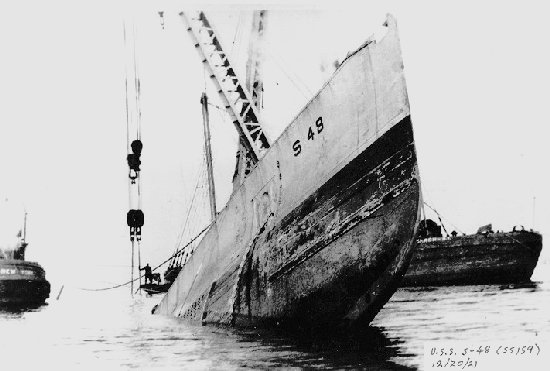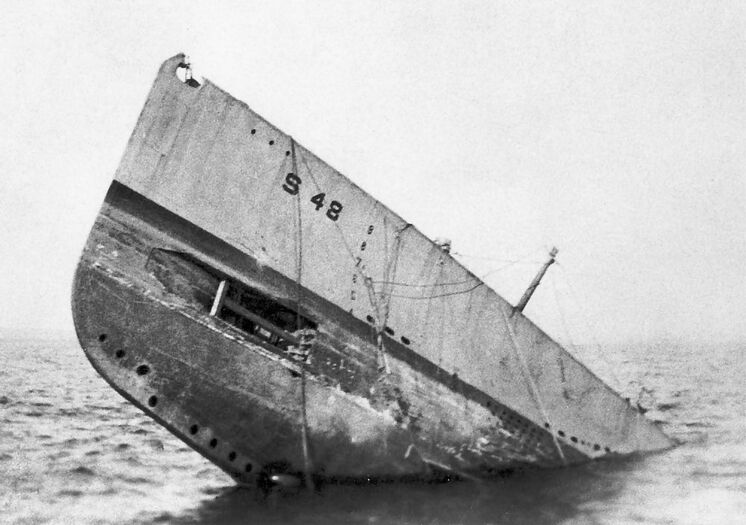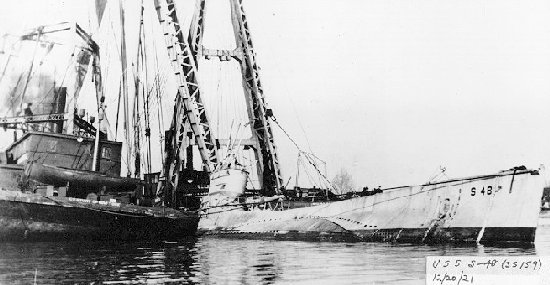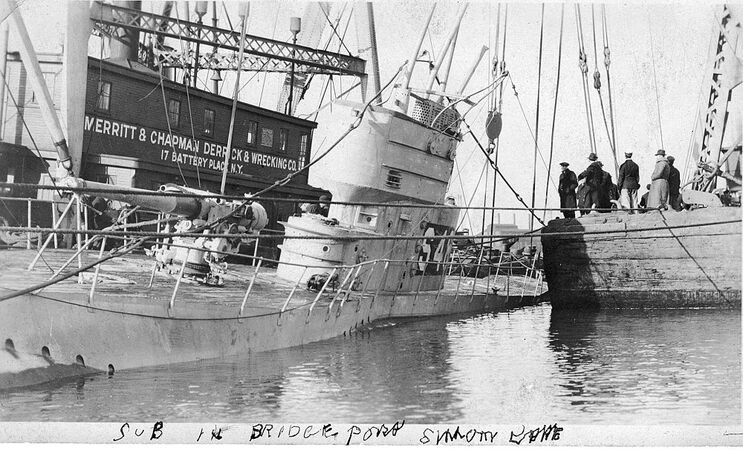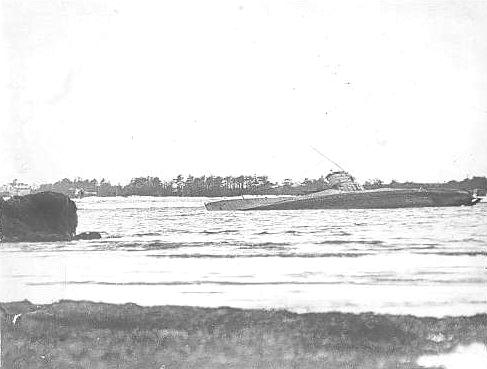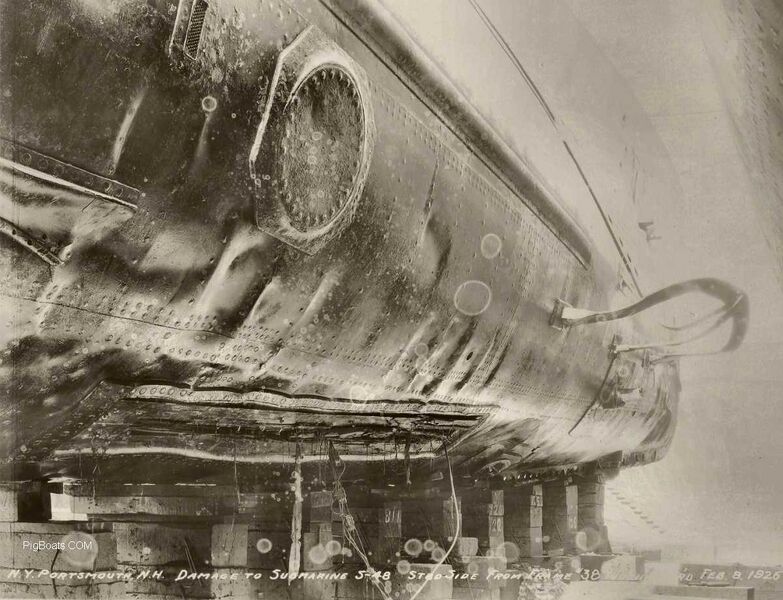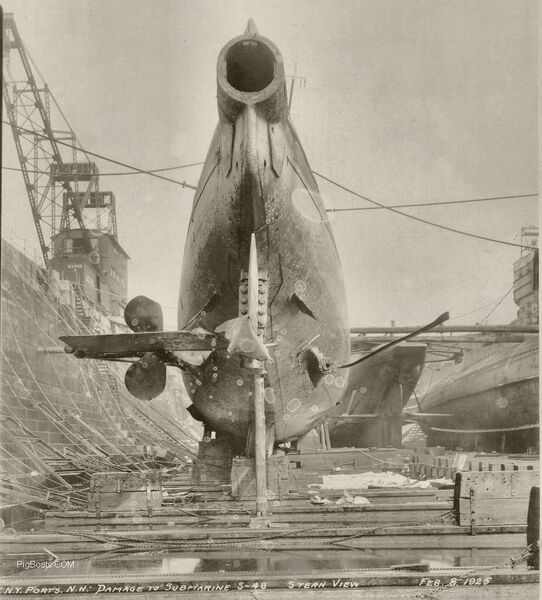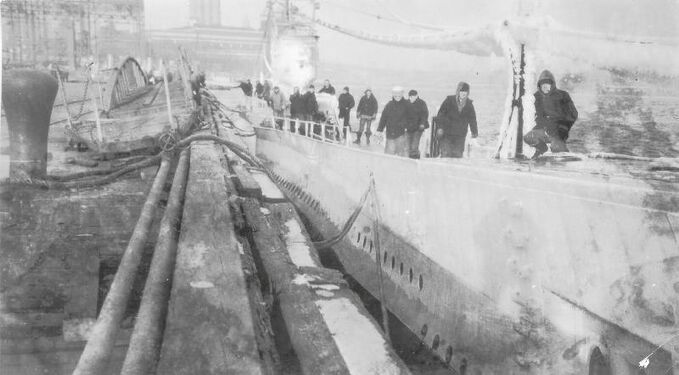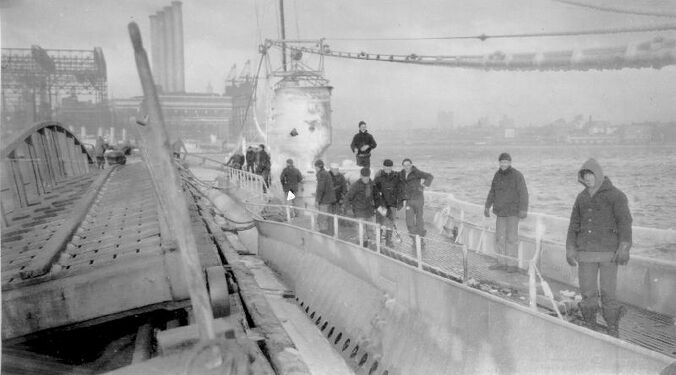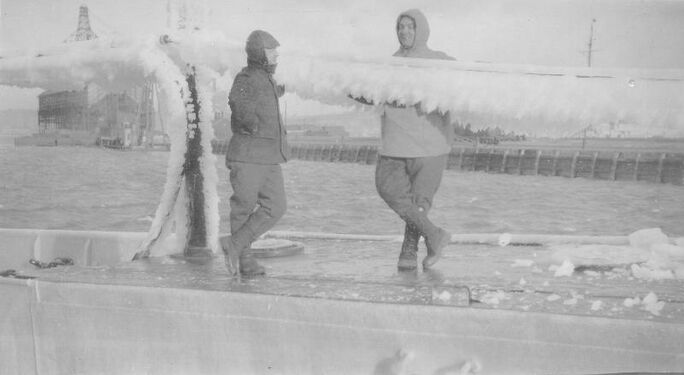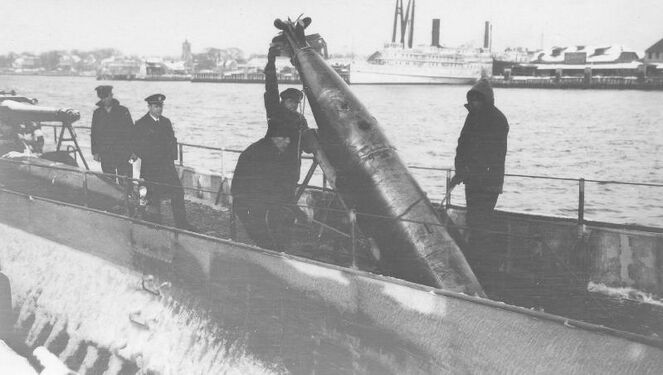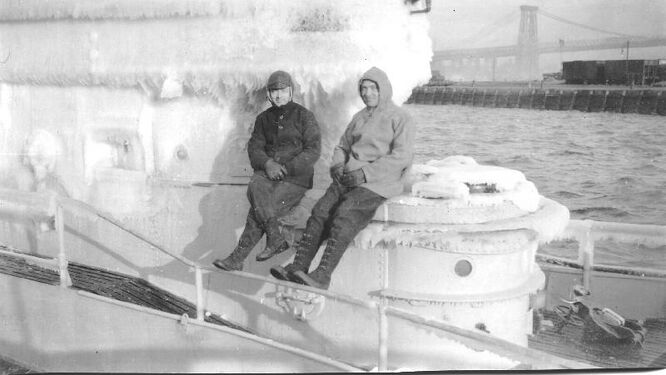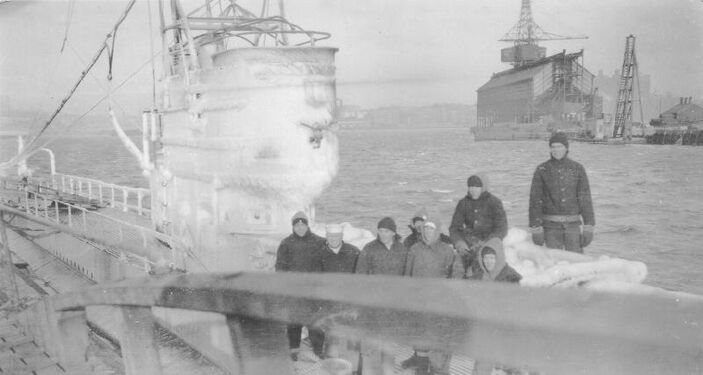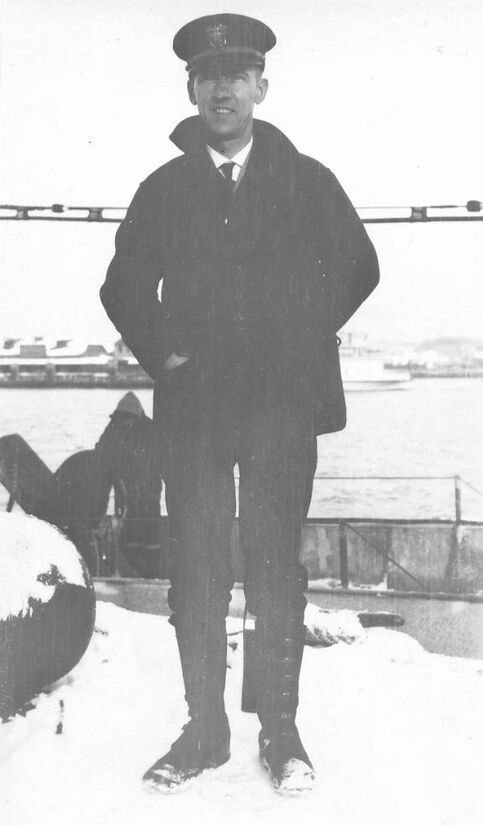S-48: Difference between revisions
Pbcjohnston (talk | contribs) Added photos and captions |
Pbcjohnston (talk | contribs) Added new Header |
||
| (7 intermediate revisions by the same user not shown) | |||
| Line 1: | Line 1: | ||
[[File:S- | [[File:New Header Govt S-class.jpg]]<br> | ||
[[File:S-48 launch 1.jpg|left|500px]] | [[File:S-48 launch 1.jpg|left|500px]] | ||
| Line 51: | Line 51: | ||
</gallery> | </gallery> | ||
</center> | </center> | ||
<div style="text-align: justify;"><span style="color:#00008B">After she was completed but before she was accepted by the Navy, a Lake company crew along with some Navy observers took S-48 out to sea on builder's trials on December 7, 1921. During a dive off Penfield Reef in Long Island Sound, S-48 sank by the stern in 60 feet of water and came to rest upright on the bottom. The Lake crew was able to blow the forward ballast tanks and they brought the bow to the surface. They disconnected the interlocks for both ends of # | <div style="text-align: justify;"><span style="color:#00008B">After she was completed but before she was accepted by the Navy, a Lake company crew along with some Navy observers took S-48 out to sea on builder's trials on December 7, 1921. During a dive off Penfield Reef in Long Island Sound, S-48 sank by the stern in 60 feet of water and came to rest upright on the bottom. A manhole cover had been left off one of the after ballast tanks and the stern of the boat quickly flooded. The Lake crew was able to blow the forward ballast tanks and they brought the bow to the surface. They disconnected the interlocks for both ends of #2 torpedo tube and escaped through the tube to a tug which took them to New York. No one was injured. These pictures were taken during the subsequent salvage operation. The photo on the right shows that the open tube's muzzle door has been shut and braced closed by wooden beams. This was done to make the forward torpedo room watertight for the salvage operation. | ||
[[File:Red bar sub new.jpg]] | [[File:Red bar sub new.jpg]] | ||
| Line 79: | Line 79: | ||
[[File:Red bar sub new.jpg]] | [[File:Red bar sub new.jpg]] | ||
<center> | |||
<div style="text-align: justify;"><span style="color:#00008B">S-48 was a hard luck boat. On the evening of January 29, 1926 she was on her way back to Portsmouth when she ran aground in a snowstorm on Jaffrey Point | <gallery mode="packed" widths="450px" heights="350px"> | ||
File:S-48 grounded 1.jpg | |||
File:S-48 port - aground-1.jpg | |||
File:S-48 port - aground-2.jpg | |||
File:S-48 port - aground-3.jpg | |||
</gallery> | |||
</center> | |||
<div style="text-align: justify;"><span style="color:#00008B">S-48 was a hard luck boat. On the evening of January 29, 1926 she was on her way back to Portsmouth when she ran aground in a blinding snowstorm on Jaffrey Point near Fort Stark on the western shore of the mouth of the Piscataqua River. She freed herself after a bit, but in the worsening weather conditions she grounded again at Little Harbor, further to the west. This time she was stuck hard and the poor weather was causing her to roll excessively on the beach. Her battery was flooding and chlorine gas forced the crew to abandon ship. The entire crew survived, but several men had to be treated for gas exposure. These photos shows her on the beach at Little Harbor on January 30, 1926. | |||
<small> | <small>All photos in the private collection of Ric Hedman.</small> | ||
[[File:Red bar sub new.jpg]] | [[File:Red bar sub new.jpg]] | ||
| Line 121: | Line 128: | ||
</center> | </center> | ||
<div style="text-align: justify;"><span style="color:#00008B">Two views of the S-48 in drydock at the Portsmouth Navy Yard, Kittery, ME. on February 8, 1926. Hull plates along her bottom have been heavily indented, her starboard bow diving plane has been ripped off and the guard bent up, and her starboard side propeller, shaft and stern diving plane have been destroyed. In the left photo the large round plate is the transducer for the Fessenden Oscillator, an early form of sonar. The damaged strip underneath it is the former location for the MV series passive sonar. The oblong housing and transducers have been completely sheared off by the grounding, leaving dangling wires. In the photo on the right, the stern torpedo tube can be seen jutting through the stern "chisel". Compare this configuration to the one for the [[S-11|'''S-11 (SS-116)''']] and the differences in the stern tube design can be clearly seen. | <div style="text-align: justify;"><span style="color:#00008B">Two views of the S-48 in drydock at the Portsmouth Navy Yard, Kittery, ME. on February 8, 1926. Hull plates along her bottom have been heavily indented, her starboard bow diving plane has been ripped off and the guard bent up, and her starboard side propeller, shaft and stern diving plane have been destroyed. In the left photo the large round plate is the transducer for the Fessenden Oscillator, an early form of sonar. The damaged strip underneath it is the former location for the MV series passive sonar. The oblong housing and transducers have been completely sheared off by the grounding, leaving dangling wires. In the photo on the right, the stern torpedo tube can be seen jutting through the stern "chisel". Compare this configuration to the one for the [[S-11|'''S-11 (SS-116)''']] and the differences in the stern tube design can be clearly seen. | ||
In the aftermath of this incident the commanding officer of the S-48, a Lieutenant Commander, was court-martialed as was customary. He was charged with negligence and failure to obey orders. The court acquitted him of all charges, although the Secretary of the Navy disapproved the finding on the 2nd of the two charges. The SecNav's disapproval carried no legal weight and in the end the acquittal stood. | |||
<small>U.S. Navy photos.</small> | <small>U.S. Navy photos.</small> | ||
| Line 170: | Line 179: | ||
[[File:S-48 panama canal.jpg|left|500px]] | [[File:S-48 panama canal.jpg|left|500px]] | ||
<div style="text-align: justify;"><span style="color:#00008B">S-48 in the Gaillard Cut of the Panama Canal, circa 1931. It is not clear which direction she is headed. Her raised bulwarks on the fore deck are visible and crew can be seen sitting on the deck just aft of the radio antenna stanchion. Other crew can be seen on the aft deck. | <div style="text-align: justify;"><span style="color:#00008B">S-48 in the Gaillard Cut of the Panama Canal, circa 1931. It is not clear which direction she is headed. Her raised bulwarks on the fore deck are visible and crew can be seen sitting on the deck just aft of the radio antenna stanchion. Other crew can be seen on the aft deck. A canvas sun awning is in place over the bridge. | ||
<small>Photos in the private collection of Ric Hedman.</small> | <small>Photos in the private collection of Ric Hedman.</small> | ||
[[File:Red bar sub new.jpg]] | |||
[[File:S-48 in Panama Canal early 1930s.jpg|left|500px]] | |||
Another view taken at nearly the same time as the photo above. This shot gives an impression of how rugged the Gaillard Cut was. It literally had to be blasted out of the mountain range that cut across the canal route, and it proved to be a major headache for the canal engineers and workers. By necessity the sides had to be steep and the torrential rains of the region made landslides a frequent occurrence. It was eventually stabilized enough to permit passage, but it remained a constant work site in order to keep clear. In recent times the cut has been greatly expanded with the sides far less steep. | |||
<small>Photo in the private collection of Ric Hedman.</small> | |||
[[File:Red bar sub new.jpg]] | [[File:Red bar sub new.jpg]] | ||
| Line 187: | Line 203: | ||
<small>U.S. Navy photo.</small> | <small>U.S. Navy photo.</small> | ||
[[File:Red bar sub new.jpg]] | |||
[[File:S-48 fairwater and crew.jpg|left|500px]] | |||
<div style="text-align: justify;"><span style="color:#00008B">This crew photo and the following closeups are dated 1934 and appears to have been taken at Coco Solo where she was stationed at that time. In July 1933, she was assigned to the Rotating Reserve and in 1935 she was ordered inactivated. She seems to be actively manned and in service in this photo. The crew of 47 men has taken the time to spread themselves around to be sure the submarines name is visible. The round logo above the Chief's heads is for Submarine Squadron Five. | |||
<small>Photo in the private collection of Ric Hedman.</small> | |||
[[File:Red bar sub new.jpg]] | |||
[[File:S-48 crew 1.jpg|left|500px]] | |||
<div style="text-align: justify;"><span style="color:#00008B">The man at the left seems to be a first class Radioman with more than eight years active duty. He is also Qualified in Submarines as seen by the cloth dolphins sewn on his right sleeve below the elbow. The four men on the right are nonrated but the stripe around and under the right shoulder means they are qualified watch standers. The man in the front right is also Qualified in Submarines. The man just to the right of the radio mast has no stripe but his left sleeve is not visible so he may be rated. His right sleeve is not visible, so it is impossible to tell if he is Submarine Qualified. | |||
<small>Photo in the private collection of Ric Hedman.</small> | |||
[[File:Red bar sub new.jpg]] | |||
[[File:S-48 crew 2.jpg|left|500px]] | |||
<div style="text-align: justify;"><span style="color:#00008B">Seven out of the ten men seen in this detail are Submarine Qualified. Two men are doubtful due the right forearm being obscured, one by a hand the other by the sleeve being pushed up. The man at lower right is not qualified at this point. We are unable to see what rates these men are. | |||
The second man seated from the left is a First Class Petty Officer with over eight years service but we are unable to tell what his rate is. The man at the top of the image is striking a pretty dramatic pose for the camera. He also seems to be maybe Hawaiian or Guamanian and at the time this was taken he would either be a cook or officer's steward. People of "color" were limited as to what they were allowed to do in the post WW I segregated Navy. | |||
<small>Photo in the private collection of Ric Hedman.</small> | |||
[[File:Red bar sub new.jpg]] | |||
[[File:S-48 crew 3.jpg|left|500px]] | |||
<div style="text-align: justify;"><span style="color:#00008B">Two of the men in this detail can be identified by rate. The man second from the left is a third class Radioman and the third man is a Third class Torpedoman, both are Submarine Qualified. The man at the far left is also Submarine Qualified but is nonrated but and a qualified watch stander. | |||
The next two men are qualified watch standers, one in the Engineering field. The man with the stripe around his left shoulder would have had a red not black stripe meaning he was striking for either Machinist Mate, Engineman, or Electricians Mate. They are not Submarine Qualified yet. | |||
The next two men are both Submarine Qualified. | |||
One of the subs life rings with the sub's name on it is hung on the side of the conning tower fairwater. The black canister probably holds a length of line attached to both the life ring and submarine. These would have been taken below before diving. | |||
<small>Photo in the private collection of Ric Hedman.</small> | |||
[[File:Red bar sub new.jpg]] | |||
[[File:S-48 crew 4.jpg|left|500px]] | |||
<div style="text-align: justify;"><span style="color:#00008B">The man in the middle in the front row is a Second Class Torpedoman and is Submarine Qualified. The other men with their right sleeves visible seem to not be Qualified yet. Two of the men in back are probably rated men and may or may not be Submarine Qualified. | |||
The man to the left of the Second Class is probably a Filipino and is most likely an officer's steward, again, due to the segregation in the services created by President Wilson that persons of "color" were restricted in jobs they were allowed to perform. | |||
The officer on the right is Submarine Qualified. He is wearing his gold plated Dolphins on his left chest. He is a Lieutenant Junior Grade indicated by the 1½ stripes on his shoulder boards. The star next to the stripes means he is a "Line Officer" and can succeed to command of a vessel. | |||
<small>Photo in the private collection of Ric Hedman.</small> | |||
[[File:Red bar sub new.jpg]] | |||
[[File:S-48 crew 5.jpg|left|500px]] | |||
<div style="text-align: justify;"><span style="color:#00008B">This is the Ward Room of the S-48, meaning the officers who commanded the crew. The men are all Lieutenants Junior Grade except the man standing between the 4 and the 8 who is a full Lieutenant and no-doubt the Commanding Officer. Given the time frame this man is likely LT Olton R. Bennehoff. We think the officer on the right is the Executive Officer (the 2nd in command) and the other two men are the Engineering and Navigation Officers. All are Submarine Qualified. | |||
<small>Photo in the private collection of Ric Hedman.</small> | |||
[[File:Red bar sub new.jpg]] | |||
[[File:S-48 crew 6.jpg|left|500px]] | |||
<div style="text-align: justify;"><span style="color:#00008B">The Chief on the left next to the officer is a Chief Machinist Mate with more than eight years service, Sub Qualified. The next chief is a Chief Torpedoman, again, with over eight years service and like wise Qualified. We can't say what the next chief is other than it is a left arm rate, maybe an Electrician. It is unknown. | |||
The next man is a fireman striker noted by the stripe over and under the left shoulder. He is a qualified watch stander and Submarine Qualified. | |||
The next man is a petty officer and is Submarine Qualified. The badge on his right arm with the star above looks to to be a Gun Pointer/Gun Director First Class badge that may mean the man is probably a Gunner's Mate and perhaps the Gun Captain for the S-48's 4"/50 caliber deck gun. | |||
The next man in the front row is a "hot running" Second Class Electricians Mate with no "hash marks" meaning he has made "rate" in under 4 years. We can't see his right arm to see if he is Qualified. The man directly behind is a First Class Electrician. The three hash marks mean over 12 years active service in the Navy and he has also Qualified in Submarines. | |||
The man in the middle moved and is, unfortunately, blurred for posterity. The next two men are Submarine Qualified. The to the left is a Third Class Petty Officer with over eight years service. Rate unknown. The man on the right is a Second Class Machinist Mate with some time over 4 years active service. | |||
Of the last two men in the second row, the man on the left is a firemen striker but that is just about all that can be found out from this photo. The man on the right is a First Class Petty Officer with over eight years service. | |||
The last two men in the third row are seen as a Third Class Petty Officer with over eight years service and the other man is a fireman striker with a hash mark meaning over 4 years service. | |||
<small>Photo in the private collection of Ric Hedman.</small> | |||
[[File:Red bar sub new.jpg]] | [[File:Red bar sub new.jpg]] | ||
Latest revision as of 19:02, 17 March 2025
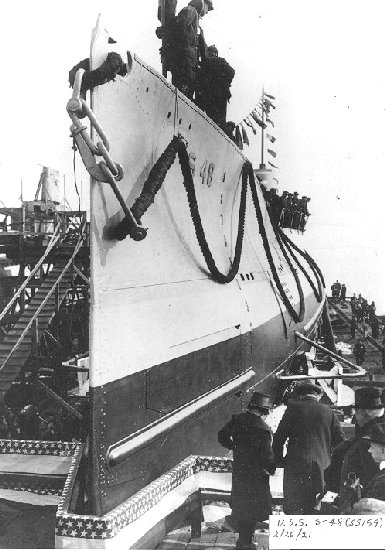
U.S. Navy photo NH 108448 courtesy of the NHHC.
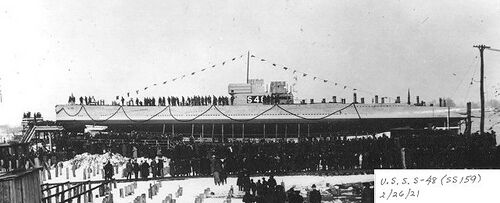
U.S. Navy photo NH 108453 via the NHHC.

There is another woman in tribal dress on the left and she is wearing a number of beaded necklaces. On her dress on the lower front is a swastika. It has nothing to do with the Nazi party at this time. It is an ancient symbol that has history going back thousands of years and has various meanings depending on the region of the world it appears. The word swastika derives from the Sanskrit "svastika" meaning "lucky or auspicious object". it is commonly used as a religious symbol in Hinduism and Buddhism. It was considered as a luck symbol in many cultures.
Photo in the private collection of Ric Hedman.
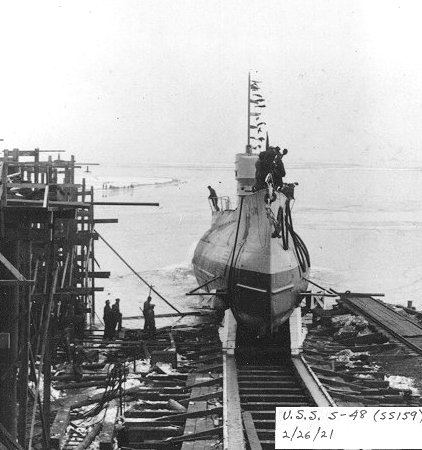
U.S. Navy photo NH 108451 courtesy of the NHHC.
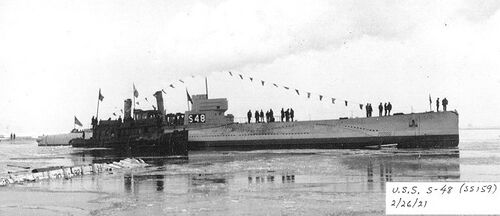
U.S. Navy photo NH 108449 courtesy of the NHHC.
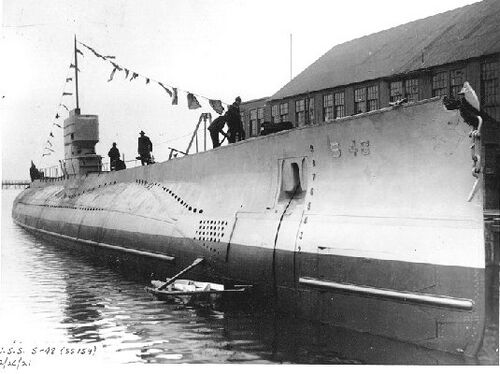
U.S. Navy photo NH 108450 courtesy of the NHHC.
-
U.S. Navy photo.
-
Photo courtesy of T. Gray Curtis.
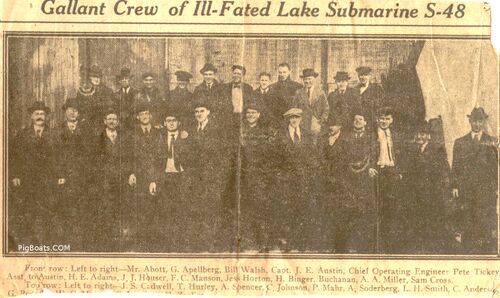
Photo in the private collection of Ric Hedman.
-
U.S. Navy photo.
-
Photo in the private collection of Ric Hedman.
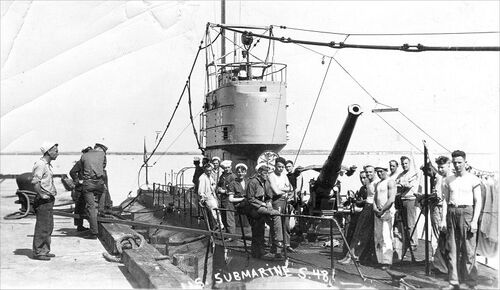
Photo in the private collection of Ric Hedman.
All photos in the private collection of Ric Hedman.
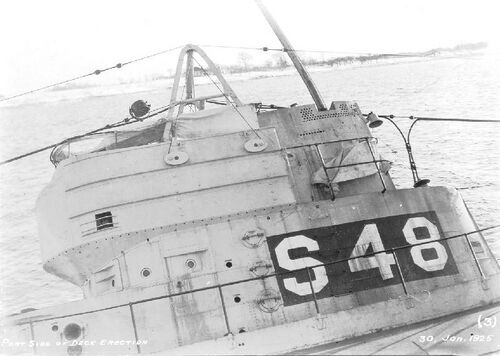
Photo in the private collection of Ric Hedman.
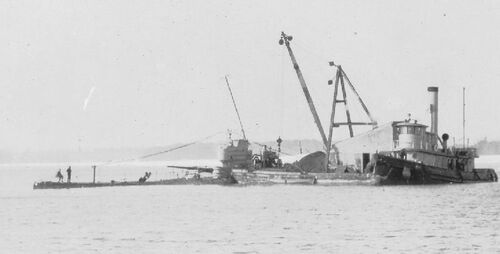
U.S. Navy photo.
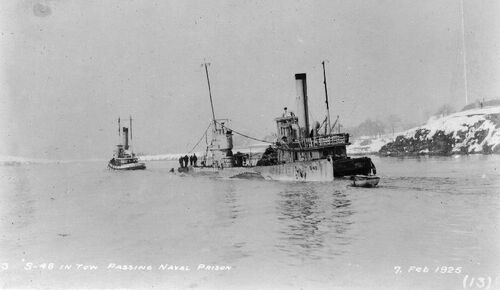
U.S. Navy photo.
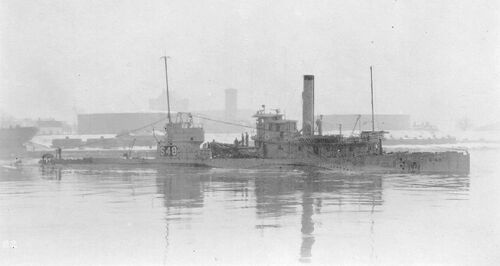
U.S. Navy photo.
In the aftermath of this incident the commanding officer of the S-48, a Lieutenant Commander, was court-martialed as was customary. He was charged with negligence and failure to obey orders. The court acquitted him of all charges, although the Secretary of the Navy disapproved the finding on the 2nd of the two charges. The SecNav's disapproval carried no legal weight and in the end the acquittal stood.
U.S. Navy photos.
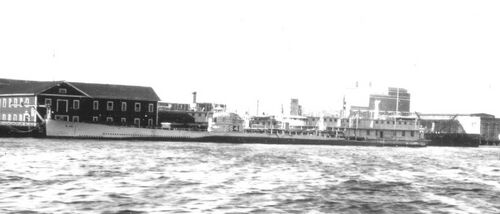
Photo in the private collection of Ric Hedman.
Photos in the private collection of Ric Hedman.
Photos in the private collection of Ric Hedman.
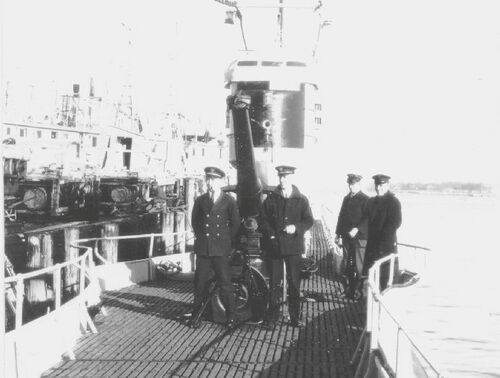
Photos in the private collection of Ric Hedman.
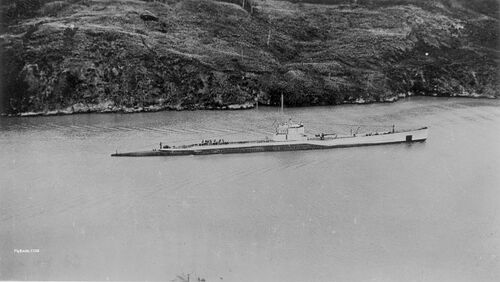
Photos in the private collection of Ric Hedman.
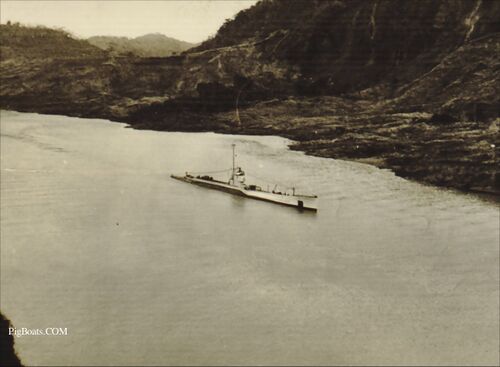
Another view taken at nearly the same time as the photo above. This shot gives an impression of how rugged the Gaillard Cut was. It literally had to be blasted out of the mountain range that cut across the canal route, and it proved to be a major headache for the canal engineers and workers. By necessity the sides had to be steep and the torrential rains of the region made landslides a frequent occurrence. It was eventually stabilized enough to permit passage, but it remained a constant work site in order to keep clear. In recent times the cut has been greatly expanded with the sides far less steep.
Photo in the private collection of Ric Hedman.
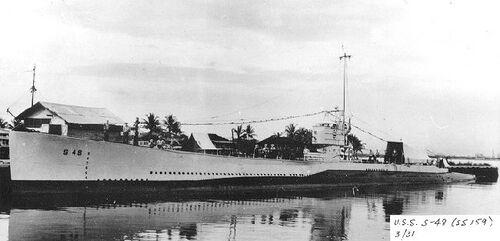
Photos in the private collection of Ric Hedman.
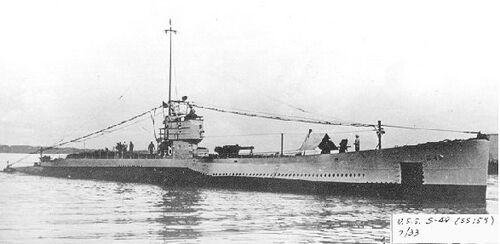
U.S. Navy photo.

Photo in the private collection of Ric Hedman.
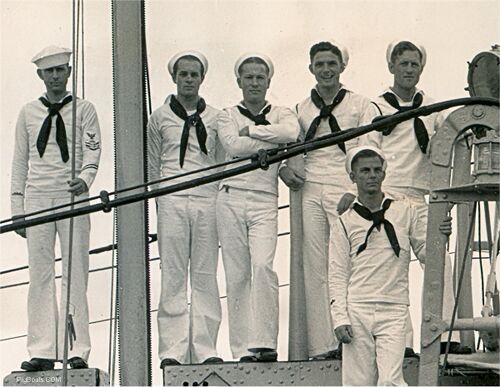
Photo in the private collection of Ric Hedman.
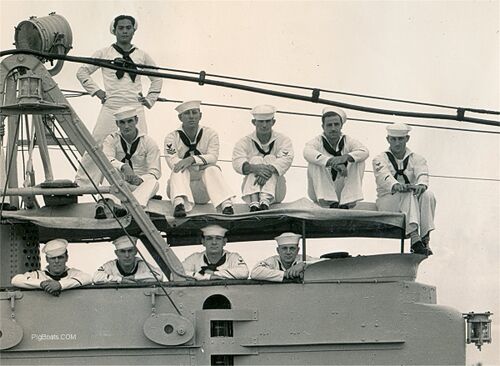
The second man seated from the left is a First Class Petty Officer with over eight years service but we are unable to tell what his rate is. The man at the top of the image is striking a pretty dramatic pose for the camera. He also seems to be maybe Hawaiian or Guamanian and at the time this was taken he would either be a cook or officer's steward. People of "color" were limited as to what they were allowed to do in the post WW I segregated Navy.
Photo in the private collection of Ric Hedman.
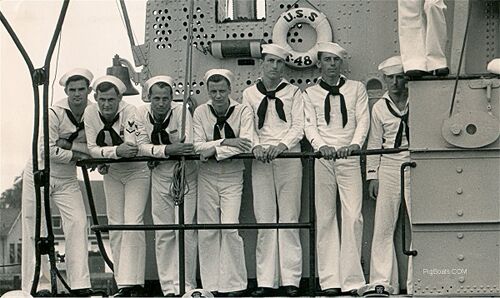
The next two men are qualified watch standers, one in the Engineering field. The man with the stripe around his left shoulder would have had a red not black stripe meaning he was striking for either Machinist Mate, Engineman, or Electricians Mate. They are not Submarine Qualified yet.
The next two men are both Submarine Qualified.
One of the subs life rings with the sub's name on it is hung on the side of the conning tower fairwater. The black canister probably holds a length of line attached to both the life ring and submarine. These would have been taken below before diving.
Photo in the private collection of Ric Hedman.

The man to the left of the Second Class is probably a Filipino and is most likely an officer's steward, again, due to the segregation in the services created by President Wilson that persons of "color" were restricted in jobs they were allowed to perform.
The officer on the right is Submarine Qualified. He is wearing his gold plated Dolphins on his left chest. He is a Lieutenant Junior Grade indicated by the 1½ stripes on his shoulder boards. The star next to the stripes means he is a "Line Officer" and can succeed to command of a vessel.
Photo in the private collection of Ric Hedman.
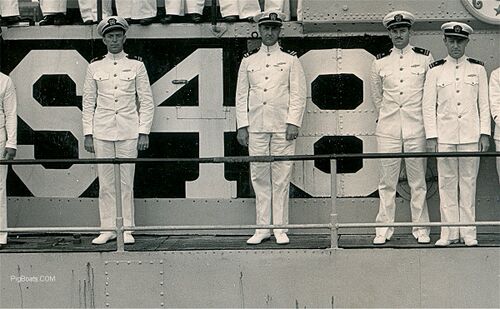
Photo in the private collection of Ric Hedman.
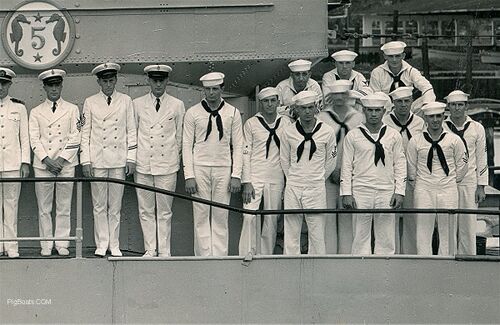
The next man is a fireman striker noted by the stripe over and under the left shoulder. He is a qualified watch stander and Submarine Qualified.
The next man is a petty officer and is Submarine Qualified. The badge on his right arm with the star above looks to to be a Gun Pointer/Gun Director First Class badge that may mean the man is probably a Gunner's Mate and perhaps the Gun Captain for the S-48's 4"/50 caliber deck gun.
The next man in the front row is a "hot running" Second Class Electricians Mate with no "hash marks" meaning he has made "rate" in under 4 years. We can't see his right arm to see if he is Qualified. The man directly behind is a First Class Electrician. The three hash marks mean over 12 years active service in the Navy and he has also Qualified in Submarines.
The man in the middle moved and is, unfortunately, blurred for posterity. The next two men are Submarine Qualified. The to the left is a Third Class Petty Officer with over eight years service. Rate unknown. The man on the right is a Second Class Machinist Mate with some time over 4 years active service.
Of the last two men in the second row, the man on the left is a firemen striker but that is just about all that can be found out from this photo. The man on the right is a First Class Petty Officer with over eight years service.
The last two men in the third row are seen as a Third Class Petty Officer with over eight years service and the other man is a fireman striker with a hash mark meaning over 4 years service.
Photo in the private collection of Ric Hedman.
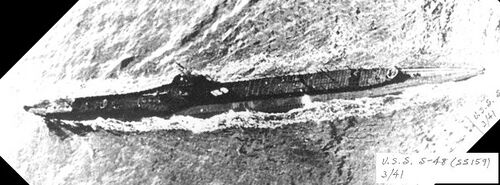
U.S. Navy photo.
Page created by:
Ric Hedman & David Johnston
1999 - 2023 - PigBoats.COM©
Mountlake Terrace, WA, Norfolk, VA
webmaster at pigboats dot com

